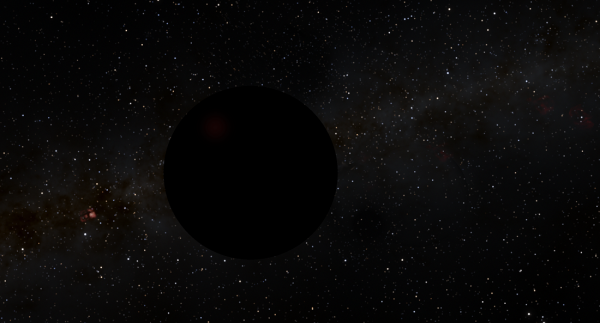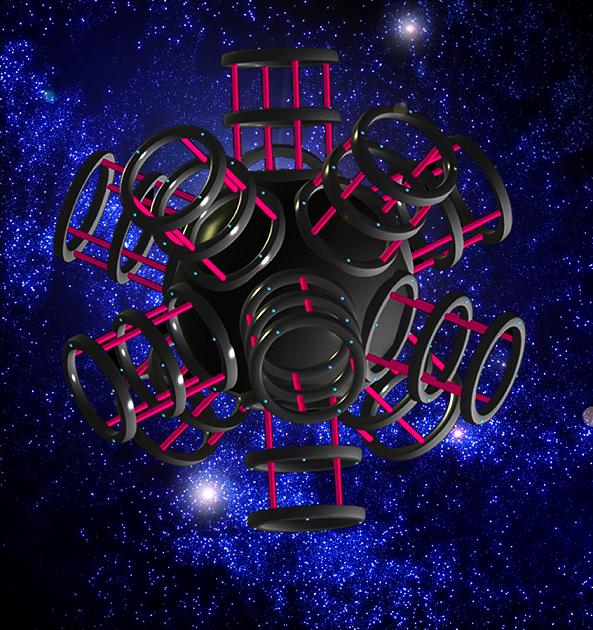BY LETTER
Argus Array
Science > Astronomy
Technology > Technology Type or Material > Drytech/Hylotech
Technology > Application > Megascale Engineering
Technology > Application > Metric Engineering
Technology > Technology Type or Material > Space-Time Engineering
Technology > Technology Levels > Transapientech / Godtech / Clarketech
Technology > Technology Type or Material > Drytech/Hylotech
Technology > Application > Megascale Engineering
Technology > Application > Metric Engineering
Technology > Technology Type or Material > Space-Time Engineering
Technology > Technology Levels > Transapientech / Godtech / Clarketech
Interstellar Telescope Array | |
 Image from Steve Bowers | |
| An Argus Array sensor element in the Current Era, this is a dark sphere 20 AU across, located in deep space. | |
Configuration
In the Current Era the Argus Array consists of 8000 dedicated telescopes, located in deep space to ensure that they are as cold as possible. Each telescope in the modern array is a gigantic black sphere, 20 AU across, supported internally by dynamic compression members. These spheres are very large, but have a very low density, each massing less than a terrestrial planet, and are constructed from matter extracted from nearby Oort Clouds.Each telescope has a single comm-gauge wormhole at its centre, connecting to the Array processor complex where the data is combined with signals from each of the other telescopes to build up a combined image in both time and space. In effect the whole array acts as an extremely long-baseline interferometer. The processing network then distributes this data to academic research institutes and a large number of other interested parties. Much of the data traffic is directed towards transapient and archailect parties.
In addition to the 8000 "official" sensor complexes there are thousands of more distant telescopes of various kinds that can be drawn upon as needed. So long as these telescopes are connected to the Known Net, the information they provide can be used, increasing the total amount of data gathered significantly.
Considering the 'core' sensors alone, the Array has a total light-gathering cross-section of just over ~10^27 square meters. This is large enough to collect photons from a range of very distant objects and form an image of those objects over time. For instance the light emitted from a one metre, sunlit object in Andromeda is sufficient to build an image in the Argus Array over a period of three standard years. Larger objects can be imaged more quickly- at the same distance, a 10km object can be seen by collecting photons over a period of just 10 seconds. This allows large-scale phenomena to be observed on the surfaces of planets, such as weather patterns. Within the Milky Way Galaxy the light-gathering capacity of the Array is significantly better, and even more so inside the Terragen Sphere. For this reason the Argus array has immense importance as a data-gathering tool within the region of Colonised Space.
Compared to the light-gathering capability of these spheres, the effective resolution is a secondary consideration; the aperture afforded by each sphere is sufficient to observe brightly luminous objects in great detail as far as the edge of the Visible Universe, and a comprehensive map of the Hubble Volume has been made since the Array was completed. The Array maintains a constant watch over the Galaxy and beyond, recording events such as novae, supernovae, collisions and stellar ignition.
History
The history of the Argus Array can be said to have begun in 3481 AT during the Consolidation Period with the construction of what would eventually be seen as the first element of the Array. At the time, the project that was begun in the Ixeway system was intended to create the largest telescope ever seen. Upon its completion in 3491 the Array admirably fulfilled this goal and made a number of significant contributions to the astronomical databases of the time.As originally conceived the Array was intended to consist only of a single ring of telescopic elements in orbit around, and getting power from, its red dwarf primary. However, over the next two and a half centuries the need for a more flexible device became more apparent and additional rings were gradually added until a total of six were in place around the star. Shortly thereafter the proposal was put forward to expand the array's baseline across interstellar distances using wormhole based communication links to synchronize operations. The MPA happened to be in an economic expansion period at this time and provided the major impetus for the project. The result was that by 3807 the array had been expanded into a complex of six identical units in a rough hexagon of six star systems.
Things might have stabilized at this point, but for the efforts and actions of the Church of the Far-Seer, an otherwise minor movement whose primary belief was that God was observing the Cosmos from the edge of the Universe and it was the mission of all true believers to seek Eir out. By a combination of political maneuvering, coincidence (many members of the church were astronomers by profession), and the support of the hyperturing Ethonos, the church gained control of Array operations and proceeded to work to expand it to a level where it could achieve their goal. This was by no means an uninterrupted process, but with the use of skillful memetic engineering, a specialized series of limited neumann, and the patronage of Ethonos the church managed to drive expansion of the array for another eight centuries until it reached its current size. The array never did achieve the church's goal of seeing God, and the point became moot some 300 years after the founding of the Church when the organization merged with Ethonos in a mass transcension to an unknown toposophic level and essentially vanished from the known galaxy.
By that time a number of other hyperturings were interested in continuing the project (later it transpired that they were the ones behind the Church of the Far-Seer in any case; an instance of memetic engineering of a memetic engineer) and took up Array operations. The full status of Ethonos in all this has never been determined, but third singularity cliological simulations show e really had little interest one way or the other, and the whole act would have never been noticed by S<1 beings were it not for eir unexpected transcension. Throughout the later Consolidation period and into the second Federation, more AIs and a number of posthuman clades became involved, and the project soon lost any traces of its religious phase, apart from the familiar iconic Eye that adorns many of the Array letterheads and is a stylized derivative of the original church's Eye of God. Even in the Current Era there are still a few isolated colonies of nearbaseline astronomer-priests belonging to several minor sects in nominal MPA space. Even today they still hold that the Argus Array's original mission is to observe a monotheistic God.
During the Version War many of the original elements of the Argus Array were destroyed as military targets, and the information network connecting the telescopes was shut down or segmented. After this period the Array was rebuilt as an array of spherical telescopes designed to increase photon collection.
As well as the Argus Array, a number of similar dark, spherical objects have been observed in deep space; exploration craft have approached a number of these objects and many have been determined to be telescopes belonging to the Panvirtuality or the Diamond Network, or constructed by independent but secretive factions such as the Xeon.
 Image from Chris Schaeffer | |
| One of the original telescopic elements of the Argus Array, now preserved as a Galactic Heritage Site | |
Argus Heritage
The Argus Array has revolutionized the field of deep space astronomy and permitted observation of events and phenomena across the universe. An unexpected side benefit of the array's construction has been the discovery of an ever growing number of apparently or obviously artificial phenomena pointing to the existence of advanced civilizations or beings in other galaxies as well as intergalactic space.Often this xenological information relates to cultures long extinct even when the light was leaving their solar system. But even those cultures current at that time may have died out in the tens of thousands of years (for our galaxy) or many millions or tens or hundreds of millions of years (for other galaxies) during which the light has travelled. Ironically, at the same time that the Array reveals the existence of many xenosophonts, including races equal in power to Terragens, it reinforces the vast loneliness of interstellar space.
The array continues to be the most powerful astronomical tool ever devised as well as a virtually permanent part of the list of the Wonders of the Galaxy.
Related Articles
- Alien Civilisations in the Local Group
- Archeocliology
- Beacon Project, The
- Cliology
- Cliotelescopy
- Deep Traveler, The
- Eyes of Neptune, The
- Golden Tower Builders, The
- Gravity Wave Detector Argus Co-Function - Text by Steve Bowers
The widely spaced gravity wave detectors developed for the Reality Intertextualization Project have also been useful in more conventional astronomy. The laser and neutrino interferometer instruments involved are now linked with the Argus Array information net to produce a gravity wave map of the universe, showing neutron stars and black holes throughout this and neighbouring galaxies. The Gravity Wave Detector Argus co-function as it is called has also produced detailed information concerning the early years, minutes and even seconds of the post-Big Bang universe, showing the fine detail of this period and the surprising complexity of the high energy cosmos. Some cosmologists and esotericists refer to this period of complexity as the Alpha, postulating an advanced intelligence or civilisation at this time of unknown origin. - Ixeway
- Sensors for use in Space Combat and Defence
- Sundrivers, The
- Triangulum Transmission, The
Appears in Topics
| Astronomy | Drytech/Hylotech | Megascale Engineering |
| Metric Engineering | Space-Time Engineering | Transapientech / Godtech / Clarketech |
Development Notes
Text by Todd Drashner, Peter Kisner, and M. Alan Kazlev
Updated by Roger and Steve Bowers, 2018
Initially published on 04 January 2002.
Updated by Roger and Steve Bowers, 2018
Initially published on 04 January 2002.






